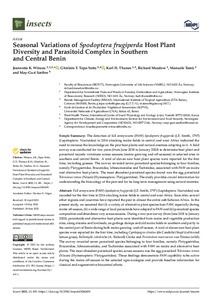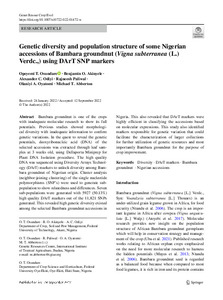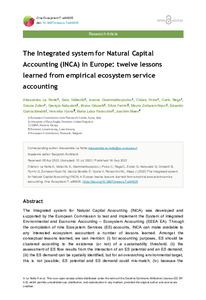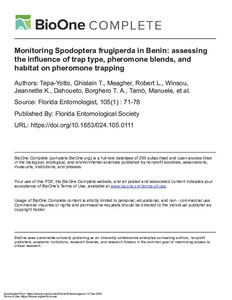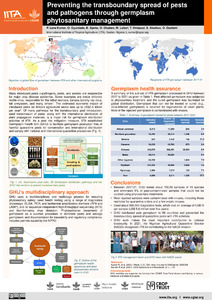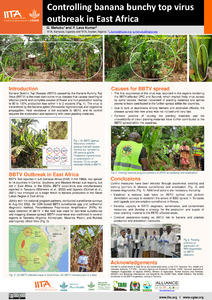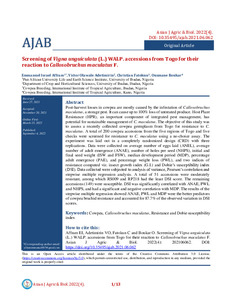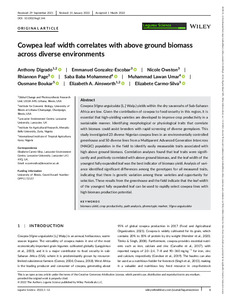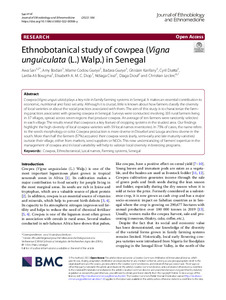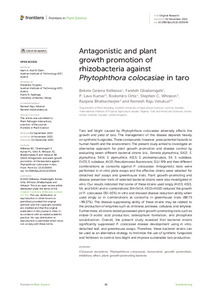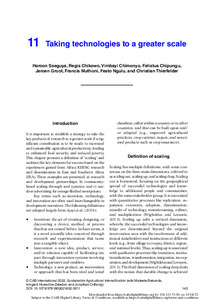Welcome to the International Institute of Tropical Agriculture Research Repository
IITA Bibliography System: Recent submissions
Now showing items 661-680 of 8099
-
Seasonal variations of Spodoptera frugiperda host plant diversity and parasitoid complex in southern and central Benin
(2022)Fall armyworm (FAW) Spodoptera frugiperda (J.E. Smith, 1797) (Lepidoptera: Noctuidae) was recorded for the first time in 2016 attacking maize fields in central and west Africa. Soon after, several other regions and countries have reported the pest in almost the entire sub-Saharan Africa. In the present study, we assumed that (i) a variety of alternative plant species host FAW, especially during maize off-season, (ii) a wide range of local parasitoids have adapted to FAW and (iii) parasitoid species ... -
Genotype-environment-interaction and stability of root mealiness and other organoleptic properties of boiled cassava roots
(2022-12-03)Genetic enhancement of cassava aimed at improving cooking and eating quality traits is a major goal for cassava breeders to address the demand for varieties that are desirable for the fresh consumption market segment. Adoption of such cassava genotypes by consumers will largely rely not only on their agronomic performance, but also on end-user culinary qualities such as root mealiness. The study aimed to examine genotype × environment interaction (GEI) effects for root mealiness and other culinary ... -
Genetic diversity and population structure of some Nigerian accessions of Bambara groundnut (Vigna subterranea (L.) Verdc.,) using DArT SNP markers
(2022-09-24)Bambara groundnut is one of the crops with inadequate molecular research to show its full potentials. Previous studies showed morphological diversity with inadequate information to confirm genetic variations. In the quest to reveal the genetic potentials, deoxyribonucleic acid (DNA) of the selected accessions was extracted through leaf samples at 3 weeks old, using Dellaporta Miniprep for Plant DNA Isolation procedure. The high quality DNA was sequenced using Diversity Arrays Technology (DArT) ... -
Yield stability of east African highland cooking banana 'Matooke' hybrids
(2022-12-08)East African banana (Musa sp.) breeding efforts have focused mainly on enhancing ‘Matooke’ productivity through the development of high-yielding, pathogen-resistant cultivars with adequate stability to contribute to regional food security. Before a breeding program can recommend promising cultivars for release, they must pass the sensory screens; be evaluated in the target population environments; and the data analyzed for yield, adaptability, and stability. Twenty-four primary and secondary ... -
The Integrated system for Natural Capital Accounting (INCA) in Europe: twelve lessons learned from empirical ecosystem service accounting
(2022-09-16)The Integrated system for Natural Capital Accounting (INCA) was developed and supported by the European Commission to test and implement the System of integrated Environmental and Economic Accounting – Ecosystem Accounting (SEEA EA). Through the compilation of nine Ecosystem Services (ES) accounts, INCA can make available to any interested ecosystem accountant a number of lessons learned. Amongst the conceptual lessons learned, we can mention: (i) for accounting purposes, ES should be clustered ... -
Monitoring Spodoptera frugiperda in Benin: assessing the influence of trap type, pheromone blends, and habitat on pheromone trapping
(2022-12-12)The fall armyworm, Spodoptera frugiperda (J. E. Smith) (Lepidoptera: Noctuidae), has now become a pest of global concern. Originally known to be endemic to the Western Hemisphere, its first detection in Africa was followed by spectacular outbreaks and spread to almost all sub-Saharan countries. The rapid incursion of S. frugiperda on maize (Zea mays L.; Poaceae) fields in Africa highlighted a crucial need for a comprehensive assessment of integrated pest management strategies in most smallholder ... -
Data-driven similar response units for agricultural technology targeting: an example from Ethiopia
(2022-07-25)Ethiopia has heterogeneous topographic, climatic and socio-ecological systems. Recommendations of agricultural inputs and management practices based on coarse domains such as agro-ecological zones (AEZ) may not lead to accurate targeting, mainly due to large intra-zone variations. The lack of well-targeted recommendations may contribute to the underperformance of promising technologies. Therefore, there is a need to define units where similar environmental and biophysical features prevail, based ... -
Epidemiological analysis of yam mosaic virus (YMV) infection risk factors and its implications for clean seed yam systems
(IInternational Institute of Tropical Agriculture, 2022-11)Yam mosaic virus (YMV) is a major threat to yam production in West Africa. This study determined factors contributing to the spread of YMV in yam fields, including the role of aphid vectors, seed-borne infections, YMV inoculum in the fields, weather, genetic diversity of the virus, and spatial distance between infected sources. The findings of this study are useful for refining YMV control measures, developing a model for disease risk assessment under different scenarios, and guiding clean seed ... -
Phenotyping cowpea for seedling root architecture reveals root phenes important for breeding phosphorus efficient varieties
(2022-02)Cowpea (Vigna unguiculata L. Walp.) is a key climate-resilient legume for food security, especially in sub-Saharan Africa. Cowpea yields are limited by edaphic stresses including drought and low phosphorus (P) availability. Identifying genotypes with advantageous root phenotypes can facilitate breeding for improved yield in marginal environments. We evaluated 50 elite genotypes from African and U.S. sources for seedling root architecture and root hair length and density. Significant genotypic ... -
Preventing the transboundary spread of pests and pathogens through germplasm phytosanitary management
(IInternational Institute of Tropical Agriculture, 2022-11)Many introduced pests (=pathogens, pests, and weeds) are responsible for major crop disease epidemics. The estimated economic impact of introduced pests on Africa's agricultural sector was up to US$3.6 trillion per year. Seed transmission of pests, along with the international distribution of plant propagation materials, is a major risk for germplasm distribution activities of IITA. As a pest risk mitigation measure, IITA established Germplasm Health Unit (GHU) to facilitate germplasm production ... -
Controlling banana bunchy top virus outbreak in east Africa
(IInternational Institute of Tropical Agriculture, 2022-11)Bananas (and plantain, Musa spp.) are the most important crops contributing to food security and the income of millions of smallholder farmers in East Africa. Banana bunchy top virus (BBTV, genus Babuvirus), an aphid-transmitted virus first reported in 2021 in Tanzania and Uganda, is wrecking banana production in several regions and threatening to spread further in East Africa. The BBTV has no effective solutions. Preventing the virus establishment is the best strategy. The remedial procedure of ... -
Screening of Vigna unguiculata (L.) WALP. accessions from Togo for their reaction to Callosobruchus maculatus F.
(2022-09-04)Post-harvest losses in cowpea are mostly caused by the infestation of Callosobruchus maculatus, a storage pest. It can cause up to 100% loss of untreated produce. Host Plant Resistance (HPR), an important component of integrated pest management, has potential for sustainable management of C. maculatus. The objective of this study was to assess a recently collected cowpea germplasm from Togo for resistance to C. maculatus. A total of 200 cowpea accessions from the five regions of Togo and five ... -
Cowpea leaf width correlates with above ground biomass across diverse environments
(2022-03-21)Cowpea (Vigna unguiculata [L.] Walp.) yields within the dry savannahs of Sub-Saharan Africa are low. Given the contribution of cowpea to food security in this region, it is essential that high-yielding varieties are developed to improve crop productivity in a sustainable manner. Identifying morphological or physiological traits that correlate with biomass could assist breeders with rapid screening of diverse germplasm. This study investigated 23 diverse Nigerian cowpea lines in an environmentally ... -
Ethnobotanical study of cowpea (Vigna unguiculata (L.) Walp.) in Senegal
(2022)Cowpea (Vigna unguiculata) plays a key role in family farming systems in Senegal. It makes an essential contribution to economic, nutritional and food security. Although it is crucial, little is known about how farmers classify the diversity of local varieties or about the social practices associated with them. The aim of this study is to characterize the farming practices associated with growing cowpea in Senegal. Surveys were conducted involving 335 rural farmers living in 37 villages, spread ... -
Antagonistic and plant growth promotion of rhizobacteria against Phytophthora colocasiae in taro
(2022)Taro leaf blight caused by Phytophthora colocasiae adversely affects the growth and yield of taro. The management of this disease depends heavily on synthetic fungicides. These compounds, however, pose potential hazards to human health and the environment. The present study aimed to investigate an alternative approach for plant growth promotion and disease control by evaluating seven different bacterial strains (viz., Serratia plymuthica, S412; S. plymuthica, S414; S. plymuthica, AS13; S. ... -
Diversity and taxonomy of the fern genus Vandenboschia Copel. (Hymenophyllaceae, Polypodiidae) in the Afro-Malagasy region and description of a new species
(2022)Vandenboschia radicans (supposedly Neotropical and African), V. speciosa (supposedly European and Macaronesian) and V. gigantea (supposedly from western Indian Ocean) are morphologically close species and often confused in collections and in floras. Moreover, the status of African populations is still strongly debated. We undertook to combine morphological, morphometrics and molecular phylogenetic analyses, on these three species, by also including the Neotropical V. collariata, morphologically ... -
Sustainable agricultural intensification: a handbook for practitioners in east and southern Africa
(CAB International, 2022-05)This book provides an insight into the background, lessons learned, and the methodology of facilitating the application of best-bet/best-fit agricultural technologies to smallholder farms in East and Southern Africa (ESA). All technologies highlighted within this book, except those on livestock feeding, were trialed and demonstrated in farmers' fields over an eight-year period [2012-2020] as part of the Feed the Future/USAID funded research-for-development Africa RISING ESA Project and supported ... -
Combining multiple technologies: integrated soil fertility management
(CAB International, 2022-05)This chapter shows how Integrated Soil Fertility Management (ISFM) can be combined and integrated further at farm and landscape levels to improve farming system performance. ISFM is an example of a system-wide technology. It is a set of soil fertility management practices, including use of industrial fertilizer, organic inputs, and improved crop varieties, combined with knowledge on how to adapt the practices to local conditions. Its benefits include agronomic efficiency, enhanced productivity, ... -
Taking technologies to a greater scale
(CAB International, 2022-05)This chapter presents a definition of 'scaling' and outlines the key elements for success based on the experiences gained from Africa RISING research and dissemination in East and Southern Africa (ESA). Three examples are presented: (a) research and development partnerships; (b) community based scaling through seed systems; and (c) outdoor advertising for orange-fleshed sweet potato. It presents experiences and lessons learned from using these approaches to transfer and scale the technologies. -
Improved technologies for reducing post-harvest losses
(CAB International, 2022-05-10)This chapter outlines several post-harvest loss reduction technologies validated by the Africa RISING program that will improve the efficacy of drying, threshing, and storage operations, and gives evidence of their potential impact. The chapter also provides evidence on the cumulative benefits of combining all three technologies.

